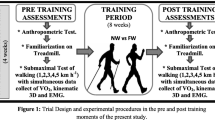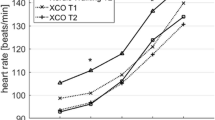Abstract
The metabolic cost of walking (C W) is increased in healthy older adults. Previously, this has been suggested to be associated with age-related decline in physiological/functional factors such as stability and muscle size and strength. Physical training can improve such factors as well as aspects of gait performance in older adults. The aim of this investigation was to determine if it also has a beneficial impact on (lowers) C W. Thirty-eight community dwelling older adults (aged 70–82 years) assigned to a training group (TRA, n=25) or a control group (CON, n=13) participated in a 12-month intervention. TRA followed a multi-component physical conditioning programme involving supervised resistance, aerobic, and balance exercises twice per week. They also undertook home based exercises once per week. CON carried on with their normal daily activities. C W and indicators of functional capacity (knee extensor isometric strength, single leg balance time, sit and reach, stand and reach, and 6 min walk distance) were assessed prior to and following the intervention. Significant improvements in knee extensor isometric strength (+21%), single leg balance time (+30%), and 6 min walk distance (+6%) were observed in TRA (P<0.05) but not in CON. However, no change in C W was observed. In conclusion, this investigation has shown that a multi-component physical conditioning programme had a beneficial impact on functional capacity but did not lower C W in healthy community dwelling older adults.



Similar content being viewed by others
References
Ades PA, Ballor DL, Ashikaga T, Utton JL, Nair KS (1996) Weight training improves walking endurance in healthy elderly persons. Ann Intern Med 124:568–572
American College of Sports Medicine (1998) Position stand: exercise and physical activity for older adults. Med Sci Sports Exerc 30:992–1008
Andersen JL (2003) Muscle fibre type adaptation in the elderly human muscle. Scand J Med Sci Sports 13:40–47
Bean JF, Kiely DK, Leveille SG, Herman S, Huynh C, Fielding R, Frontera W (2002) The 6-minute walk test in mobility-limited elders: what is being measured? J Gerontol A Biol Sci Med Sci 57:M751–756
Beneke R, Meyer K (1997) Walking performance and economy in chronic heart failure patients pre and post exercise training. Eur J Appl Physiol Occup Physiol 75:246–251
Buschman HP, Elzinga G, Woledge RC (1996) The effects of the level of activation and shortening velocity on energy output in type 3 muscle fibres from Xenopus laevis. Pflugers Arch 433:153–159
Cunningham DA, Rechnitzer PA, Donner AP (1986) Exercise training and the speed of self-selected walking pace in men at retirement. Can J Aging 5:19–26
Frontera WR, Suh D, Krivickas LS, Hughes VA, Goldstein R, Roubenoff R (2000) Skeletal muscle fiber quality in older men and women. Am J Physiol Cell Physiol 279:C611–C618
Grimston SK, Nigg BM, Hanley DA, Engsberg JR (1993) Differences in ankle joint complex range of motion as a function of age. Foot Ankle 14:215–222
Hausdorff JM, Nelson ME, Kaliton D, Layne JE, Bernstein MJ, Nuernberger A, Fiatarone Singh MA (2001a) Etiology and modification of gait instability in older adults: a randomized controlled trial of exercise. J Appl Physiol 90:2117–2129
Hausdorff JM, Rios DA, Edelberg HK (2001b) Gait variability and fall risk in community-living older adults: a 1-year prospective study. Arch Phys Med Rehabil 82:1050–1056
Hawkins SA, Wiswell RA (2003) Rate and mechanism of maximal oxygen consumption decline with aging: implications for exercise training. Sports Med 33:877–888
Himann JE, Cunningham DA, Rechnitzer PA, Paterson DH (1988) Age-related changes in speed of walking. Med Sci Sports Exerc 20:161–166
Judge JO, Underwood M, Gennosa T (1993) Exercise to improve gait velocity in older persons. Arch Phys Med Rehabil 74:400–406
Krebs DE, Jette AM, Assmann SF (1998) Moderate exercise improves gait stability in disabled elders. Arch Phys Med Rehabil 79:1489–1495
Krustrup P, Soderlund K, Mohr M, Bangsbo J (2004) Slow-twitch fiber glycogen depletion elevates moderate-exercise fast-twitch fiber activity and O2 uptake. Med Sci Sports Exerc 36:973–982
Lamoureux EL, Murphy A, Sparrow A, Newton RU (2003) The effects of progressive resistance training on obstructed-gait tasks in community-living older adults. J Aging Phys Act 11:98–110
Larish DD, Martin PE, Mungiole M (1988) Characteristic patterns of gait in the healthy old. Ann NY Acad Sci 515:18–32
Lemmink K, Kemper HCG, de Greef MHG, Rispens P, Stevens M (2003) The validity of the sit-and-reach test and the modified sit-and-reach test in middle-aged to older men and women. Res Q Exerc Sport 74:331–336
Malatesta D, Simar D, Dauvillier Y, Candau R, Borrani F, Prefaut C, Caillaud C (2003) Energy cost of walking and gait instability in healthy 65- and 80-year-olds. J Appl Physiol 95:2248–2256
Margaria R (1976) Biomechanics and energetics of muscular exercise. Oxford University Press, Oxford, UK
Martin PE, Morgan DW (1992) Biomechanical considerations for economical walking and running. Med Sci Sports Exerc 24:467–474
Martin PE, Rothstein DE, Larish DD (1992) Effects of age and physical activity status on the speed-aerobic demand relationship of walking. J Appl Physiol 73:200–206
McCann DJ, Adams WC (2002) A dimensional paradigm for identifying the size-independent cost of walking. Med Sci Sports Exerc 34:1009–1017
Morse CI, Thom JM, Mian OS, Muirhead A, Birch KM, Narici MV (2005) Muscle strength, volume and activation following 12-month resistance training in 70-year-old males. Eur J Appl Physiol 95:197–204
Oberg T, Karsznia A, Oberg K (1993) Basic gait parameters: reference data for normal subjects, 10–79 years of age. J Rehabil Res Dev 30:210–223
Ralston HJ (1958) Energy–speed relation and optimal speed during level walking. Int Z Angew Physiol 17:277–283
Roach KE, Miles TP (1991) Normal hip and knee active range of motion: the relationship to age. Phys Ther 71:656–665
Samson MM, Crowe A, de Vreede PL, Dessens JA, Duursma SA, Verhaar HJ (2001) Differences in gait parameters at a preferred walking speed in healthy subjects due to age, height and body weight. Aging (Milano) 13:16–21
Saunders PU, Pyne DP, Telford RD, Hawley JA (2004) Factors affecting running economy in trained distance runners. Sports Med 34:465–485
Schlicht J, Camaione DN, Owen SV (2001) Effect of intense strength training on standing balance, walking speed, and sit-to-stand performance in older adults. J Gerontol A Biol Sci Med Sci 56:M281–M286
Seynnes O, Fiatarone Singh MA, Hue O, Pras P, Legros P, Bernard PL (2004) Physiological and functional responses to low-moderate versus high-intensity progressive resistance training in frail elders. J Gerontol A Biol Sci Med Sci 59A:503–509
Sipila S, Multanen J, Kallinen M, Era P, Suominen H (1996) Effects of strength and endurance training on isometric muscle strength and walking speed in elderly women. Acta Physiol Scand 156:457–464
Steffen TM, Hacker TA, Mollinger LA (2002) Age- and gender-related test performance in community dwelling elderly people: six-minute walk test, berg balance scale, timed up and go test, and gait speeds. Phys Ther 82:128–137
Thom JM, Mian O, Ardigò LP, Muirhead A, Minetti AE, Narici MV (2003) Metabolic cost of walking at set and self-selected speeds in older males and females. Med Sci Sports Exerc 35(Suppl 1):S296
Waters RL, Lunsford BR, Perry J, Byrd R (1988) Energy speed relationship of walking—standard tables. J Orthop Res 6:215–222
Acknowledgements
Supported by European Commission Framework V funding (‘Better-Ageing’ Project, No. QLRT-2001-00323). The resistance machines used in this study were provided courtesy of Technogym®. We thank Andrea Muirhead for delivering the training programme.
Author information
Authors and Affiliations
Corresponding author
Rights and permissions
About this article
Cite this article
Mian, O.S., Thom, J.M., Ardigò, L.P. et al. Effect of a 12-month physical conditioning programme on the metabolic cost of walking in healthy older adults. Eur J Appl Physiol 100, 499–505 (2007). https://doi.org/10.1007/s00421-006-0141-9
Accepted:
Published:
Issue Date:
DOI: https://doi.org/10.1007/s00421-006-0141-9




